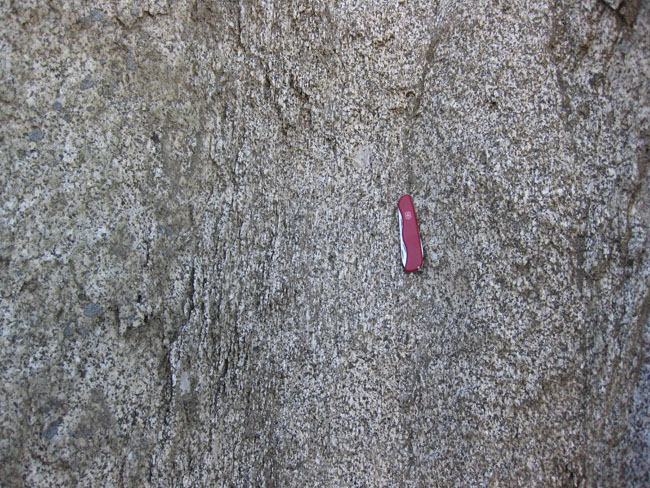For the final installment of our Transitions of the Rock Cycle series, I present to you the Boulder Batholith:

This is a Cretaceous granite of western Montana, basically an eastern extension of the Idaho Batholith. This outcrop is just southeast of Butte. It’s full of xenoliths:

But the xenoliths aren’t why we’re here to look at it today – it’s the weathering we’re interested in. We’ve seen sedimentary rock turn into metamorphic rock, and metamorphic rock beginning to melt. Now we want to see an igneous rock turning to sediment.
Note all the vertical fractures in this next image, and the fusty granite that surrounds those fractures:

A closer look at the fractured granite:

With the rock all broken up like that, you can imagine that it won’t last long. As the outcrop casts off feldspar crystals, quartz grains, and lithic fragments, they pile up at the base of the outcrop as the coarse sediment called grus (rhymes with “goose”). Here are some grus deposits, with individual layers inclined away from the outcrop (i.e., to the left) at the angle of repose:

Here’s a Macro GigaPan of similar grus, from the Sierra Nevada of California:
link
Now for some Photoshop-stitched outcrop images. There’s a lot to see in these, and I encourage you to click through and enlarge them to ~14 MB size…
Annotated version:
And here’s one that features a prominent kernstone, the hard “core” inside a zone of spheroidal weathering:
Annotated:
 Click to enlarge
Click to enlarge
An animated GIF that scrolls from the aplite dike to the kernstone below it:

What once was magma, and then igneous rock, is now transforming into loose sediment. Stripped away by the Clark Fork river, these grains will be transported downstream, ground down and rounded, sorted and sieved, and eventually deposited, perhaps in the waters off coastal Oregon.
The cycle returns to its origins; we’re back to where we started.




Nice photos. I loves me some granite. I would call those mafic enclaves, though. Xenoliths (IMO) implies pieces of solid country rock. I bet you these were blobs of mafic magma.